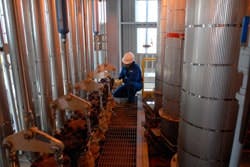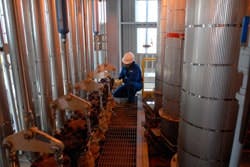Retirement: Companies Keep Know-how in Place
The impending retirement of large numbers of engineers is forcing chemical industry companies to grapple with how to retrieve as much useful information as possible from aging staffs as well as how best to store and re-use this knowledge in a way that will improve business performance. At least a few firms already are well along in their efforts. Take, for example, Air Products, Allentown, Pa. Although reluctant to mention specific numbers, the company admits a significant portion of its senior technical staff will be eligible for retirement over the next few years. Fortunately, the company began to tackle knowledge-transfer issues in 2000 when it restructured its business units into one global company managed by 11 key global processes. "As part of this regrouping we needed to be able to transfer knowledge much more consistently. Then about three years ago we looked at particular applications of knowledge management — especially its retention and transfer. This is really important in light of the people coming up to retirement. To compete globally we have to utilize our knowledge much more efficiently," explains Karen Castillo, lead project engineer in the company's Global Engineering Organization (GEO). [pullquote]Air Products participated in a benchmarking study by the American Product Quality Center (APQC), Houston, to learn best practices from other companies. "We observed that we were actually using a lot of the same techniques — such as shadowing and mentoring — but that we needed to apply them in a better way. So in 2008 we kicked off a specific pilot project to further develop these tools and processes," says Vince Grassi, director, global learning and knowledge management. The pilot, which ends this September, focuses on 20 individuals with critical knowledge in a variety of areas. They include process engineers, product development engineers, liquefied-natural-gas heat exchanger engineers and cold box designers (Figure 1).
Figure 1. Company quest: Air Products almost a decade
ago began major efforts to capture critical knowledge.
Source: Air Products.
Figure 2. Community spirit: BASF has established a
centralized technical community to simplify information
exchange.
Source: BASF.
Quick Poll
Services in TransitionAt the same time, however, the state of the market is changing the demands being made on companies that provide training. "We've done a full revitalization of our training portfolio, given the current economic climate and the reluctance of customers to travel. So the focus is very much now on the customer location," says Vikas Dhole, vice president of engineering and product management for AspenTech, Burlington, Mass. Gone are the one- or two-day chunks of traditional training at an Aspen center, to be replaced with one- or two-hour modules for on-site use. The company did a number of test runs with new modular courses in December and by July hopes to start unveiling modular packages of its flagship simulation products. "These start with E&C [engineering and construction], refining and chemicals. We are finding that customers are demanding more and more problem-solving skills — so we are bridging a gap that in the old days was filled by in-house training and mentoring," notes Dhole. "So far the feedback has been extremely positive, but it is a culture change and it will take time to be accepted." In another sign of the times, AspenTech holds at least one web seminar every month; popular topics routinely attract global audiences of 200 or more. Over the last two years more than 12,000 people have registered to take part. The company has noticed a number of demographic issues at its customers. "In the current economic climate, people in E&C have stopped taking early retirement. These companies are also suffering from the downturn in investment in the 1990s when the oil price was very low and few people were hired — so that today they have a lot of experienced people in the 45-plus age group, with a small peak in the 25–30 age range. But it is the unhealthy dip in the 30–45 age range that concerns them a lot," says Sanjeev Mullick, director of product marketing. Another sign of the times is that vendors that provide information services are becoming much more focused on knowledge retention and management. One such example is Knovel, New York, which offers web-based information services targeted at engineers. "The original idea was to deliver something that hands information down better than a book and there were already a lot of online services doing that in the areas of finance and law, for example," explains Chris Forbes, CEO. The challenge for Knovel has been to integrate what it supplies with what the end-user actually needs. "So we provide not only the service, for example, physical property data, but the tools on top that allow engineers to manipulate information and pull it easily into their workflows." He cites work carried out recently with Bechtel. Originally the demand was for access to a good library. But now the E&C company has a series of internal web-based applications delivered by a central engineering group. "They need this institutional knowledge, especially with large numbers of people retiring soon." A major petrochemical customer expects 50% of its engineering workforce to retire in the next five years, he adds. "So they have many things to do and one is invest in Knovel because we provide continuity for a certain class of information." "We recognize that there are issues and things that need to be done, for example, the easier capture of tribal knowledge. So we are working on that and hopefully by the end of the year we will have a new tool that will make information more easily available to both the individual and the company," says Forbes. A Crucial NeedDevelopments that help to improve efficiency are vital, notes Roger Parsons, senior process development engineer with Lubrizol, Wickliffe, Ohio, a Knovel customer. Over the past two decades Lubrizol has made large workflow improvements by flattening organizational structure, using cross-functional teams, providing better connectivity to work faster and more in parallel and better anticipating downstream issues. "This has worked so well for us that we can now generate information faster than existing human/software interfaces can truly master," he says. Two opportunities are emerging for capturing knowledge in the broadest sense. "First, we can no longer afford to wait for that final encyclopedic report which was the norm 20 years ago," Parson explains. "The ongoing storm of data, insights and inquiry must be shared broadly as it unfolds, if we are to harness the full wisdom of our teams to speed innovation. Second, the profound knowledge that builds from myriad anecdotes and incomplete or even failed, but informative, studies can be too confined to the heads of technical professionals. And the gestalt that comes from that collection often drives our most useful and commercially valuable technical insights." Natural career progressions create turnover. "In my department — process development — we might get three to five years from the average engineer. Transitioning their undocumented insights and observations to their successors may be our greatest untapped efficiency gain," he says. For knowledge capture in general, Lubrizol, like many other companies, has adopted the latest integrated control systems and enterprise resource planning software, and has highly developed its intranet. Parsons emphasizes that next knowledge capture gain must be organic — it can't be an extra task on top of data generation, interpretation and real-time sharing within work teams. E-mail exemplifies this organic aspect, he says, but its searchability is ripe for improvement, and content organization by its nature rarely approaches that of the average Wikipedia entry. The Internet's weblog model might play a part, but he wonders whether it's possible to successfully adapt it to the less populous, more specialized and more secure environment of an individual company. Parsons speculates that the transition to new methodologies may ultimately prove generational: "New graduates don't just learn to use new web tools, like older technical professionals do. They internalize the new ways of thinking, making them uniquely second nature. The generation that learns to expect instant access to seemingly limitless information at home seems unlikely to tolerate less mind-enhancement at work." The path of the coming revolutions in knowledge capture, sharing and retention/retrieval will be hard to predict, he says, but some of the heaviest lifting may fall to specialty information companies such as Knovel. For example, Lubrizol already uses Knovel to provide Google-like searchability to engineers who know and expect that kind of tool. The searches give ranked content hits on complex search strings from within a broad collection of key technical references such as various engineering handbooks and physical property data. "This makes their entire library as portable as our laptops, and as quickly and usefully searchable as the public Internet." Nevertheless, Parsons believes that the untapped potential is much larger: "The companies that master this coming marriage of personal grey matter with silicon will have a profound edge, so long as their focus remains on enhancing what their companies already do best — making and selling their products and services." Seán Ottewell is Chemical Processing's Editor at Large. You can e-mail him at[email protected].


